Vine Invaders:
Four Invasive Vines Wreaking Havoc in the Hudson Valley
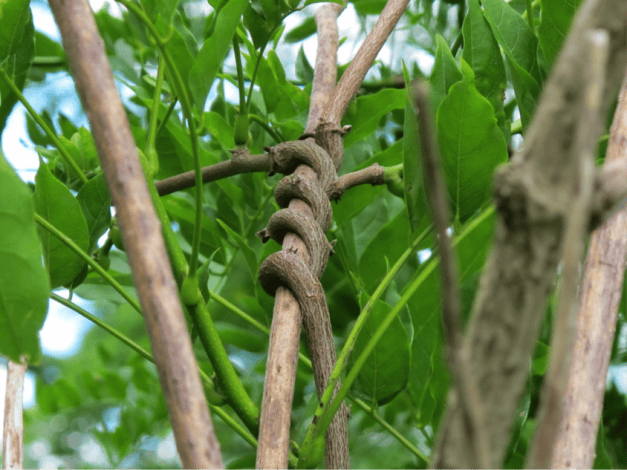
We have a vine problem here in the Lower Hudson Valley, here in Westchester County, here at Teatown. Invasive vines present a serious threat to native plant communities, forests, and backyards alike. They are something Teatown’s preserve technicians are constantly battling. Odds are, these invasives are already in your neighborhood, even in your backyard. Identifying them and implementing management strategies are two steps we can take in slowing their growth and saving our native plants.
Oriental Bittersweet
Celastrus orbiculatus
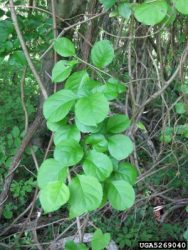 If Teatown produced a horror film, Oriental bittersweet would be the monster. This fast-growing, (up to 60 feet in one year!), twining, woody vine aggressively clings to neighboring plants, ruthlessly wrapping itself around them like a boa constrictor. It grows thick and wide, like wet rope, weighing down trees, eventually causing dieback and collapse. Left untreated, it can single-handedly strangle mature trees and decimate small forests.
If Teatown produced a horror film, Oriental bittersweet would be the monster. This fast-growing, (up to 60 feet in one year!), twining, woody vine aggressively clings to neighboring plants, ruthlessly wrapping itself around them like a boa constrictor. It grows thick and wide, like wet rope, weighing down trees, eventually causing dieback and collapse. Left untreated, it can single-handedly strangle mature trees and decimate small forests.
Fruits of Oriental bittersweet are yellow and red, and cluster along the vine as opposed to its native counterpart, American bittersweet, whose fruits are orange and only appear at the end of the vine.
Like other invasives, Oriental bittersweet is well adapted for survival: it produces rapidly through underground root systems, making it difficult to eradicate by cutting or digging. Like the monster in a horror franchise, it just keeps coming back. Unfortunately, the most effective eradication method is herbicide. But simply being aware of the plant and manually removing it from trees and plants is better than nothing. At the least, it keeps the monster at bay.
Japanese Honeysuckle
Lonicera japonica Thunb.
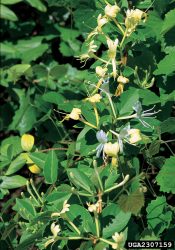 A villain in disguise, Japanese honeysuckle is a desirable and highly utilized ornamental that has quickly become a problem in Westchester County and beyond due to its fast growth rate and ability to displace native plant species. Don’t let its beautiful flowers or sweet vanilla scent fool you; this vine is ruthless.
A villain in disguise, Japanese honeysuckle is a desirable and highly utilized ornamental that has quickly become a problem in Westchester County and beyond due to its fast growth rate and ability to displace native plant species. Don’t let its beautiful flowers or sweet vanilla scent fool you; this vine is ruthless.
While it doesn’t grow nearly as fast or as monstrously as Oriental bittersweet, Japanese honeysuckle possesses the same aptitude for disrupting native habitats by climbing, twining, and strangling its neighbors. In full sun, it forms large tangles that smother vegetation, and can even girdle trees, removing sections of bark and killing them from the top down.
Japanese honeysuckle is slightly more manageable than Oriental bittersweet and can be picked by hand in small patches. However, large infestations require mowing at least twice per year and, in some cases, demand the use of herbicide.
Porcelain berry
Ampelopsis glandulosa var. brevipedunculata
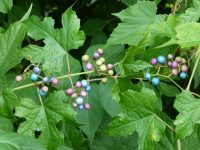 Another smothering vine set on taking over the world one forest at a time, porcelain berry can outcompete and dominate native shrubs, plants, and trees. Like honeysuckle and bittersweet, it is a highly invasive smotherer that grows fast and has very few native predators.
Another smothering vine set on taking over the world one forest at a time, porcelain berry can outcompete and dominate native shrubs, plants, and trees. Like honeysuckle and bittersweet, it is a highly invasive smotherer that grows fast and has very few native predators.
When its Easter-egg-colored berries aren’t present, porcelain berry can look very similar to the native grape vine. The leaves are alike (almost maple-shaped) and both will grow unwieldy if allowed to. The main difference is in the umbrella-shaped flower head, which grows upright on the vine, as opposed to grapes, which hang down on their vines.
Porcelain berry can be tough to wrangle because of its hardy underground root system. It spreads outwards and spurs new growth that can quickly become overwhelming to a garden or backyard. The best method for management is to lift the vine away and cut at the stems. The more of the vine you pull away, the easier it is to identify where to make additional cuts.
Wild Grape Vine
Vitis vinifera sylvestris
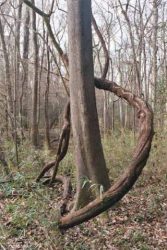 An invasive in disguise. While technically native, wild grape vine causes just as much damage to our forests as the other vines on this list. It piggybacks onto trees and overcrowds the canopy, inhibiting a tree’s ability to photosynthesize. Long-term, grapevine can physically weigh down a tree, and can cause collapse in the winter from snow and ice.
An invasive in disguise. While technically native, wild grape vine causes just as much damage to our forests as the other vines on this list. It piggybacks onto trees and overcrowds the canopy, inhibiting a tree’s ability to photosynthesize. Long-term, grapevine can physically weigh down a tree, and can cause collapse in the winter from snow and ice.
Wild grape vine has a woody, shreddy bark, and often grows up along with a tree as the tree grows. The leaves are simple, toothed, lobed, and large (up to 9 inches wide), making them perfect for covering the leaves of the tree its slowly killing.
Cutting the vine a few feet above the ground is an effective control method, though if the vine has reached the forest canopy, it may be too late to save the tree. The vine will resprout from the stump, but will likely die within a few years if the forest canopy is dense because grape vines are shade-intolerant.

ABOUT THE AUTHOR
Kevin Sterne
Kevin is an artist, writer, and Teatown’s maintenance guy. You can often find him on the trails with his dog Kodi saying hi to the trees. He loves Neil Young and is an advocate for trees via his organization savethecedars.org, which really needs a web designer.


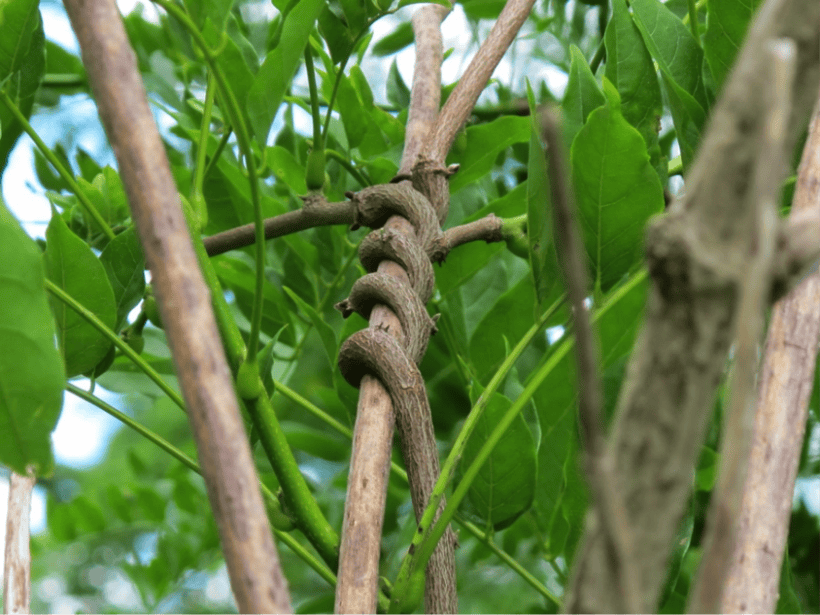
Leave a Reply